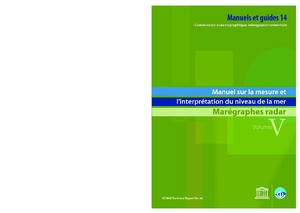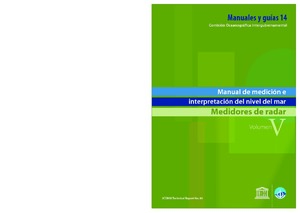| dc.contributor.editor | Woodworth, Philip | |
| dc.contributor.editor | et al | |
| dc.date.accessioned | 2017-03-17T18:08:16Z | |
| dc.date.available | 2017-03-17T18:08:16Z | |
| dc.date.issued | 2016 | |
| dc.identifier.citation | Woodworth, P.L. et al (eds) (2016) Manual on Sea-level Measurements and Interpretation, Volume V: Radar Gauges. [includes Supplement Practical Experiences] . Paris, UNESCO, 104pp, & Supplement 126pp. (Intergovernmental Oceanographic Commission Manuals and Guides;14, Vol. V), (JCOMM Technical Report; 89). DOI https://doi.org/10.25607/OBP-1444 | |
| dc.identifier.other | IOC/2016/MG/14 VOL.5 | |
| dc.identifier.uri | http://hdl.handle.net/11329/306 | |
| dc.identifier.uri | http://dx.doi.org/10.25607/OBP-1444 | |
| dc.description.abstract | Volume 5 which
is devoted specifically to ‘Radar Tide Gauges’. Radar range
finders have been used in industry (where they measure
the levels of liquids in tanks) and hydrology (for measuring
river, lake and reservoir levels) for many years and, in the
decade since Volume 4, have been applied to measuring
sea level at many locations. They have already replaced
the previous tide gauge technologies in many countries.
Their low cost (in most cases) and the fact that they are
relatively easy to install and maintain mean that they
have been the technology of choice whenever new sites
have been instrumented or older ones refurbished. They
can be interfaced easily to data loggers and telemetry
platforms, such that their data can be displayed almost
instantly at centres around in the world. However, many
questions remain as to their suitability for sea level
monitoring within national and international networks
such as GLOSS. At the 13th
meeting of the GLOSS Group
of Experts in Liverpool in November 2013, a new edition
of the Manual was proposed that would focus on this
particular technology and problems with its use... | en_US |
| dc.language.iso | en | en_US |
| dc.publisher | Intergovernmental Oceanographic Comission of UNESCO | en_US |
| dc.relation.ispartofseries | Intergovernmental Oceanographic Commission Manuals and Guides;14, Vol. V | |
| dc.relation.ispartofseries | JCOMM Technical Report;89 | |
| dc.subject.other | Tide gauges | en_US |
| dc.subject.other | Sea level measurement | en_US |
| dc.subject.other | GLOSS | en_US |
| dc.subject.other | Radar gauges | en_US |
| dc.subject.other | Telemetry | en_US |
| dc.title | Manual on Sea-level Measurements and Interpretation, Volume V: Radar Gauges. [includes Supplement Practical Experiences] | en_US |
| dc.title.alternative | Manuel sur la mesure et l'interprétation du niveau de la mer, v. V: marégraphes radar | |
| dc.title.alternative | Manual de medición e interpretación del nivel del mar v. V: medidores de radar | |
| dc.type | Report | en_US |
| dc.description.status | Published | en_US |
| dc.format.pages | 104pp. & Supplement 126pp. | en_US |
| dc.description.notes | This report has a Supplement titled Practical Experiences | en_US |
| dc.description.refereed | Refereed | en_US |
| dc.publisher.place | Paris, France | en_US |
| dc.subject.parameterDiscipline | Parameter Discipline::Physical oceanography | en_US |
| dc.subject.instrumentType | Instrument Type Vocabulary::sea level recorders | en_US |
| dc.subject.dmProcesses | Data Management Practices::Data acquisition | en_US |
| dc.description.currentstatus | Current | en_US |
| obps.resourceurl.publisher | http://unesdoc.unesco.org/images/0024/002469/246981e.pdf | en_US |
| obps.resourceurl.publisher | http://unesdoc.unesco.org/images/0024/002469/246981f.pdf | |
| obps.resourceurl.publisher | http://unesdoc.unesco.org/images/0024/002469/246981s.pdf | |
| obps.resourceurl.publisher | http://www.psmsl.org/train_and_info/training/manuals/ | |
 Repository of community practices in Ocean Research, Applications and Data/Information Management
Repository of community practices in Ocean Research, Applications and Data/Information Management


